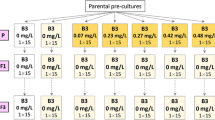Abstract
The aim of this paper was to examine the sublethal toxic effects of nonylphenol ethoxylate (NP10EO), its primary degradation product nonylphenol (NP), and their mixture on Moina macrocopa. Chronic toxicity tests were carried out by using sublethal chemical concentrations. Results showed that all treatments reduced the survivorship, body length, and reproduction of M. macrocopa with NP being 10 %–20 % more toxic to M. macrocopa than NP10EO. Results also indicated that the toxic effects of NP10EO and NP mixture on M. macrocopa were more severe than that of any single chemical alone. At the highest concentration in this experiment, 0.337 mg L−1 NP10EO plus 0.0154 mg L−1 NP treatment caused the survivorship of M. macrocopa to zero, neonates number of reproductions to zero, 45.5 % reduction in the body length, and 88 % reduction in the total neonates number.





Similar content being viewed by others
References
Baer N, Owens D (1999) Evaluation of selected endocrine disrupting compounds on sex determination in Daphnia magna using reduced photoperiod and different feeding rates. Bull Environ Contam Toxicol 62:214–221
Baldwin S, Graham E, Shea D, LeBlanc A (1997) Metabolic androgenization of female Daphia magna by the xenoestrogen 4-nonylphenol. Environ Toxicol Chem 16:1905–1911
Barata C, Porte C, Baird D (2004) Experimental designs to assess endocrine disrupting effects in invertebrates: a review. Ecotoxicology 13:511–517
Blackburn A, Waldock J (1995) Concentration of alkylphenols in rivers and estuaries in England and Wales. Water Res 29:1623–1629
Burak S (1997) Life tables of Moina macrocopa (Straus) in successive generations under food and temperature adaptation. Hydrobiologia 360:101–108
Christina L, Matthew B, Tamara G (2008) Effects of 4-nonylphenol on the endocrine system of the shore crab, Carcinus maenas. Environ Toxicol 23:309–318
Crisp M, Clegg D, Cooper L, Wood P, Anderson G et al (1998) Environmental endocrine disruption: an effects assessment and analysis. Environ Health Perspect 106:11–56
Dinan L, Bourne P, Whiting P, Dhadialla S, Hutchinson H (2001) Screening of environmental contaminants for ecdysteroid agonist and antagonist activity using the Drosophila melanogaster B11 cell in vitro assay. Environ Toxicol Chem 20:2038–2046
Eric P, James M, Chris W (2004) Effects of chronic waterborne nickel exposure on two successive generations of Daphnia Magna. Environ Toxicol Chem 23:1051–1056
Fen J, Jian Y, Min Y (2007) Vertical distribution of nonylphenol and nonylphenol ethoxylates in sedimentary core from the Beipaiming Channel, North China. J Environ Sci-China 19:353–357
Garcia G, Nandini S, Sarma S (2004) Effect of cadmium on the population dynamics of Moina macrocopa and Macrothrix triserialis (Cladocera). Bull Environ Contam Toxicol 72:717–724
LeBlanc A (2007) Crustacean endocrine toxicology: a review. Ecotoxicology 16:61–81
Nandini S, Mayeli M, Sarma S (2004) Effect of stress on the life-table demography of Moina macrocopa. Hydrobiologia 526:245–254
Nice E, Thorndyke C, Morritt D, Steele S, Crane M (2000) Development of Crassostrea gigas larvae is affected by 4-nonylphenol. Mar Pollut Bull 40:491–496
Sandrine M, Frederica A (2010) Effects of chronic uranium exposure on life history and physiology of Daphnia magna over three successive generations. Aquat Toxicol 99:309–319
Severin F, Welzel G, Juttner I, Pfister G, Schramm W (2003) Effects of nonylphenol on zooplankton in aquatic microcosms. Environ Toxicol Chem 22:273–2738
Shang Y, Macdonald W, Ikonomou G (1999) Persistence of nonylphenol ethoxylate surfactants and their primary degradation products in sediments from near a municipal outfall in the Strait of Georgia, British Columbia, Canada. Environ Sci Technol 33:1366–1372
Soares A, Guieysse B, Jefferson B, Cartmell E, Lester N (2008a) Nonylphenol in the environment: a critical review on occurrence, fate, toxicity and treatment in wastewaters. Environ Int 34:1033–1049
Soares S, Nakagawa Y, Tayama K (2008b) Genotoxic effects of environmental estrogen-like compounds in CKO-K1 cells. Mutat Res 649:114–125
Teurnear B (2004) Biodegradation of nonylphenol ethoxylates. Master dissertation, Lund University, Sweden, 46 p
Thiele B, Gunther K, Schwuge J (1997) Alkylphenol ethoxylates: trace analysis and environmental behavior. Chem Rev 97:3247–3272
White R, Jobling S, Hoare A, Sumpter P, Parker G (1994) Environmentally persistent alkylphenolic compounds are estrogenic. Endocrinology 136:175–182
Xuelei H, Jingyun Z, Shunshan D (2011) Synergistic toxic effects of nonylphenol and nonylphenol ethoxylate on Moina macrocopa. Ecol and Environ Sci 20:1725–1730
Yokota H, Seki M, Maeda M, Oshima Y, Tadokoro H, Honjo T, Kobayashi K (2001) Life cycle toxicity of 4-nonylphenol to medaka (Oryzias latipes). Environ Toxicol Chem 20:2552–2560
Zou E (2005) Impacts of xenobiotics on crustacean molting: the invisible endocrine disruption. Integr Comp Biol 45:33–38
Zou E, Fingerman M (1997) Effects of estrogenic xenobiotics on molting of the water flea, Daphnia magna. Ecotoxicol Environ Saf 38:281–285
Acknowledgments
This study was supported by the Natural Science Foundation of China-Guangdong Province Joint Key Project (U1133003), and the Natural Science Foundation of China (41176104).
Author information
Authors and Affiliations
Corresponding author
Rights and permissions
About this article
Cite this article
Hu, Xl., Sun, Zw., Wang, Jj. et al. Sublethal Toxic Effects of Nonylphenol Ethoxylate and Nonylphenol to Moina macrocopa . Bull Environ Contam Toxicol 93, 204–208 (2014). https://doi.org/10.1007/s00128-014-1310-x
Received:
Accepted:
Published:
Issue Date:
DOI: https://doi.org/10.1007/s00128-014-1310-x




